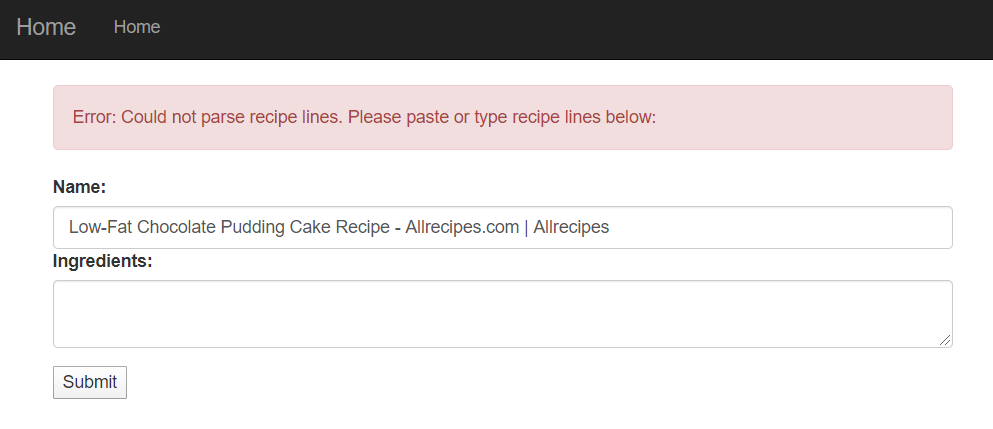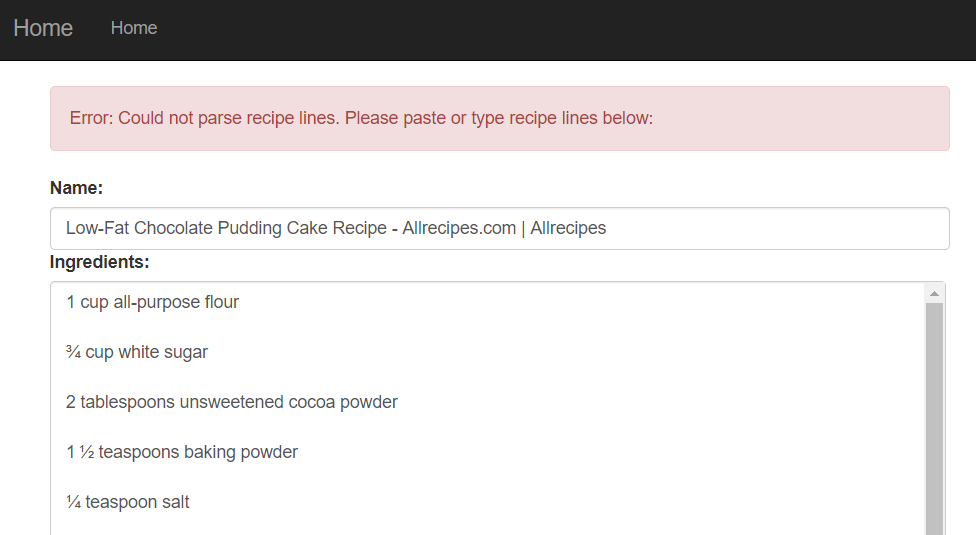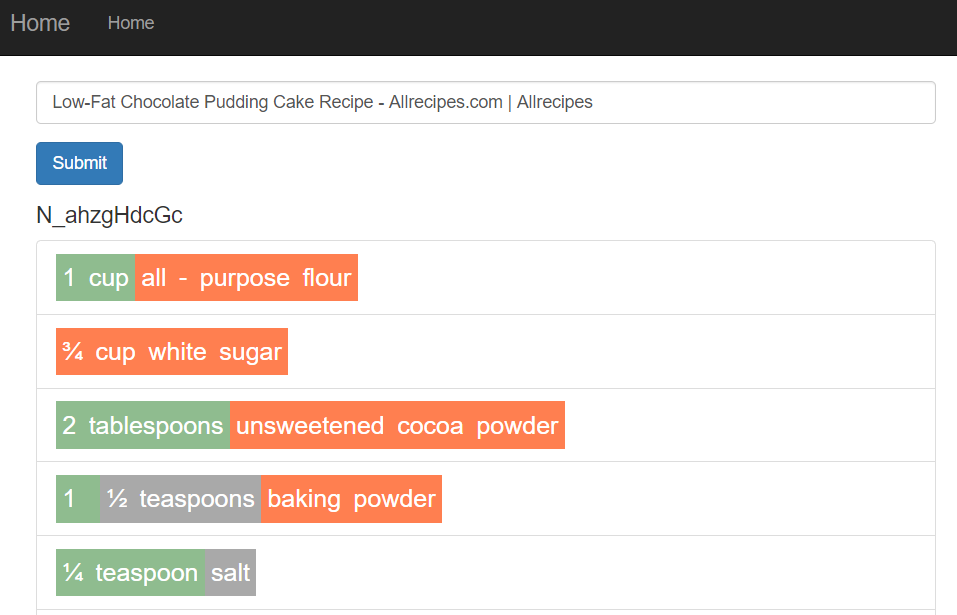Now that the basic functionality of cleaning and adding new lines is working successfully, it’s time to expand the options a user has to make use of those features. The first way I want to do that is to give the user the ability to add custom recipes. Additionally, I want this ability to function as a fallback, in case the program fails to properly parse the recipe from the urls (which happens a lot right now, although to be fair I haven’t touched that part of the program in a long time). Seeing as this functionality can effectively kill two birds with one stone, I decided that I was going to implement it next.
First, I created a new form in my forms.py file, consisting of a <textarea> tag that would enable multi-line entering of a recipe:
class CustomRecipeForm(FlaskForm):
name = StringField("Name:")
recipe_lines = TextAreaField("Ingredients:")
submit = SubmitField("Submit")Then, I created a new html template for users who want to enter in a manual recipe. This template will also double as the fallback page if the program fails to successfully parse the recipe.
{% extends 'layout.html' %}
{% block content %}
<form method="POST" action="">
{{ form.hidden_tag() }}
<div class="form-group">
{{ form.name.label(class="form-control-label") }}
{{ form.name(class="form-control") }}
{{ form.recipe_lines.label(class="form-control-label") }}
{{ form.recipe_lines(class="form-control") }}
</div>
<div class="form-group">
{{ form.submit }}
</div>
</form>
{% endblock content %}As you can see, the page is extremely simple right now. But it has all the functionality I need to get a barebones version of this working.
From there, it was time to actually allow the user to access the page. I decided that I would first create the situation where a failed parse defaulted to this page, because that’s a situation I’ve been dealing with a lot, and at present it was a fairly big hole in my workflow.
First, I had to decide how the program would detect a failed parse. I mulled over several different ways to do this, and ultimately decided that the best place to do so would be after the RecipeList had already been created. This meant that I could still use the “/list/
@main.route('/list/<string:list_name>/add/<string:new_recipe>', methods=['GET', 'POST'])
def add_recipe(list_name, new_recipe):
rlist = RecipeList.query.filter_by(hex_name=new_recipe).first_or_404()
rlist_lines = RawLine.query.filter_by(rlist=rlist).all()
if not rlist_lines: # we failed to extract any lines from the recipe
form = CustomRecipeForm()
if form.validate_on_submit():
pass # placeholder for now
form.name.data = rlist.name
flash('Error: Could not parse recipe lines. Please paste or type recipe lines below: ', 'danger')
return render_template('custom_add_recipe.html', form=form, rlist=rlist)Note also here that I finally implemented a flash() feature in the program. Until now I hadn’t needed to, but I knew that it was going to come up eventually. It’s set up in my “layout.html” file like so:
<div class="container" role="main">
{% with messages = get_flashed_messages(with_categories=true) %}
{% if messages %}
{% for category, message in messages %}
<div class="alert alert-{{ category }}">
{{ message }}
</div>
{% endfor %}
{% endif %}
{% endwith %}
{% block content %}{% endblock %}
</div>That aside, this enabled me to successfully display the “custom_add_recipe.html” template:

Next, I needed to fill in the code in the form.validate_on_submit() function (the one that uses a pass above). This was an excellent opportunity to learn a new bit of Python syntax: the filter() function. For testing purposes, I was copying a recipe from Allrecipes.com, and the recipe would paste out double-spaced. Then, when I ran a splitlines() function, the program would parse out the blank lines as recipe lines. To complicate things further, these lines were not just empty strings; they generally had a whitespace character in them as well.
My solution was to write a filter function that returned false if the list was empty or only whitespace, and true otherwise. From there, I repeated a snippet of code from my utils.py folder to parse the recipe lines through my (still only partially trained) spaCy model:
if form.validate_on_submit():
recipe_lines = form.recipe_lines.data.splitlines()
def elim_blanks(line): # function to remove blank lines and spaces from list
if not line or line.isspace():
return False
else:
return True
recipe_lines = filter(elim_blanks, recipe_lines)
for num, line in enumerate(recipe_lines): # FIXME: this code is the same as in utils.url_to_recipe
recipe_colors = color_entities_in_line(line)
recipe_line = RawLine(full_text=line, rlist=rlist, id_in_list=num, text_to_colors=recipe_colors)
db.session.add(recipe_line)
rlist.name = form.name.data
db.session.commit()
return redirect(url_for('main.add_recipe', list_name=list_name, new_recipe=new_recipe))Thus I was able to go from this…

… to this!

And from there, the rest of my code continues to function as normal. Now, I’ll need to add an option to create a new recipe like this from the beginning, but that’s a topic for my next post.